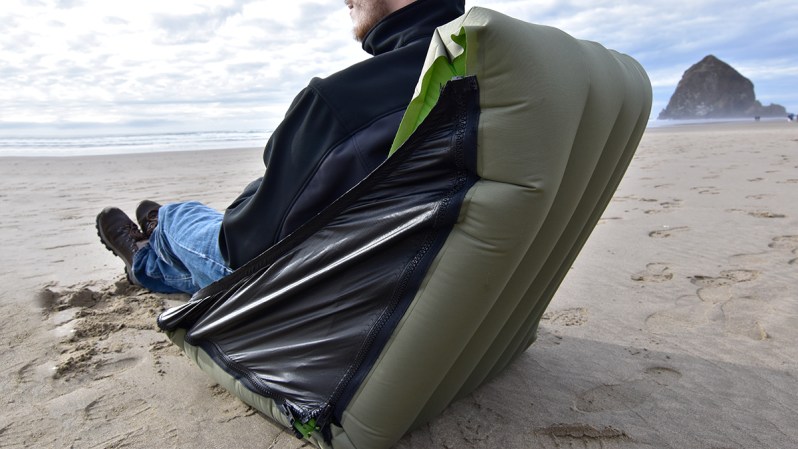Often, the best products are those that perform multiple functions without sacrificing quality of performance in any of the roles they play. A good spork, for example, can be used to enjoy a bowl of soup or a plate of pasta. A claw hammer drives in nails with aplomb yet can also pull them right back out again (as you bent the third goddamn nail in a row, narrowly missing your fingers in the process). On the other hand, some things that try to perform multiple functions end up doing none of them well. The Chevy El Camino car/truck and the mullet haircut are both example, and can regularly be found together.
Here’s some good news for you hiker and camper types out there: The new Trio mattress pad/chair/pillow from Pac Back Gear falls into the former category. When I say new, I mean it; as of this writing, the Pac Back Trio is still in its Kickstarter phase, and hope it will move into full production soon. Why? Because I got a prototype of this plucky, versatile pad, and I’m already sold on the concept and impressed with the hardware. I can only imagine that the final product will be even further improved. We’ll get to that later. First, the backstory.

The idea for the Trio was conceived by a pair of hiking buddies named Lily D’Amico and John Stone. During a particularly long backpacking trip along Oregon’s Salmonberry River, D’Amico and Stone spent a lot of time resting on the I-beams of the train tracks that ran alongside the river. Anyone who has ever done a lot of hiking will tell you that sitting down for the occasional break is essential to enjoying the trek. Anyone who has spent a lot of time sitting on cold, hard metal will tell you that it’s less than comfortable. But what’s the distance hiker to do? Every ounce of gear matters, so you can’t well tuck a camp chair in with your gear. And an unfurled air mat provides a bit of comfort for that tired rump, but it won’t give you any support if you want to be seated upright. Unless it could …
The Pac Back Gear Trio is really nothing more than an air mattress with a few zippers and clips attached and a couple of panels of zipper-lined fabric. But these zippers and clips, when properly connected to one another, convert the flat mattress pad into a soft, supportive seat in which a full grown adult can lounge comfortably. While you are sitting in the Trio in its chair position, the attached panels and clips hold the backrest in place while your own weight keeps the backrest stable and the seat anchored. I’ve spent a good amount of time sitting in my Trio now, and it’s genuine comfortable, unlike many of the camping/bleacher seats that use a similar approach. (For example, many use straps instead of a panel of fabric, and the anchor points of the straps often tug uncomfortably against the legs and across the back.)
As an air mat, the Trio is also quite comfortable. At three inches thick when fully inflated, it provides plenty of cushioning, support, and decent insulation, helping keep you warm when you’re camped out on the cold ground. Frankly, the mat could be a solid inch thinner and still provide adequate cushioning and support while weighing a bit less and occupying less room in your backpack. That’s something I’ll be looking for in future versions, though other people may be glad to have a slightly larger pad to enjoy more padding and insulation.

The name Trio comes from the fact that when not being used as a chair, the fabric panels can be zipped open and stuffed with clothes to make a pillow. (Chair, pad, pillow = three, or trio, see?) As a pillow is another luxury to which few trekkers treat themselves, this is another marked benefit.
Here’s the thing: You don’t need to bring a chair or a pillow on a trek. The ground works fine for the former, and a balled up coat or fleece will serve as the latter. But most of us do carry an air mat when we’re sleeping out in the wild. So why not carry an air mat that can also serve as a chair and pillow? Yes, this mat is larger than many options and weighs a bit more, but when you can kick back in comfort any time along the trail or at camp, and when you can rest your head in comfort, why not do it? That’s worth a few extra ounces to me, anyway.
Hopefully Pac Back will make it into the mainstream and soon be adding just a bit of weight in exchange for a whole lot of comfort to backpackers everywhere. If you’re smitten with the concept, then you should probably back the Kickstarter campaign before it ends on December 14, 2017.



